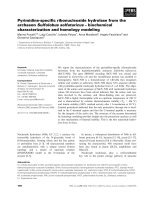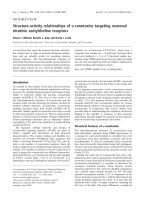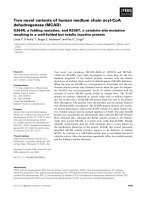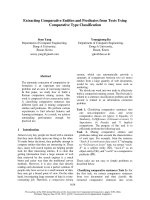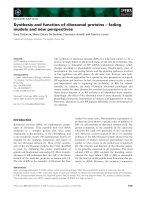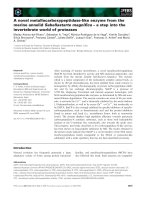Báo cáo khoa học: Two different types of hepcidins from the Japanese flounder Paralichthys olivaceus ppt
Bạn đang xem bản rút gọn của tài liệu. Xem và tải ngay bản đầy đủ của tài liệu tại đây (336.44 KB, 8 trang )
Two different types of hepcidins from the Japanese
flounder Paralichthys olivaceus
Ikuo Hirono, Jee-Youn Hwang, Yasuhito Ono, Tomofumi Kurobe, Tsuyoshi Ohira, Reiko Nozaki
and Takashi Aoki
Laboratory of Genome Science, Graduate School of Marine Science and Technology, Tokyo University of Marine Science and Technology,
Japan
Antimicrobial peptides are important molecules in the
innate immune system. Hepcidin is an antimicrobial
peptide that acts against Gram-negative and Gram-
positive bacteria and yeast [1–3]. Hepcidin is a 20- or
25-residue peptide containing four disulfide bonds that
is expressed in the liver [1,2]. Recently, hepcidin has
been proposed to also act as a central regulation of
intestinal iron absorption and iron recycling by macro-
phage [4,5]. Hepcidin inhibits the iron absorption in
the small intestine, the release of recycled iron from
macrophages, and the transport of iron across the pla-
centa. Expression of the hepcidin gene in mice is
enhanced by iron overload, interleukin 6 and lipopoly-
saccharide (LPS) [6–9]
Recently, several fish hepcidin cDNAs and genes
were cloned and sequenced [3,10,11]. Previous reports
of fish hepcidin were mostly concerned with sequencing
and expression of some genes using RT-PCR. The only
fish hepcidin whose antimicrobial activity has been
characterized so far is bass, Morone chrysops hepcidin
Keywords
antimicrobial peptide; gene expression;
hepcidin; Japanese flounder Paralichthys
olivaceus
Correspondence
Takashi Aoki, Laboratory of Genome
Science, Graduate School of Marine Science
and Technology, Tokyo University of Marine
Science and Technology, Konan 4-5-7,
Minato-ku, Tokyo 108–8477, Japan
Fax: +81 3 54630690
Tel: +81 3 54630556
E-mail:
(Received 17 May 2005, revised 13 July
2005, accepted 18 August 2005)
doi:10.1111/j.1742-4658.2005.04922.x
The cysteine-rich peptide hepcidin is known to be an antimicrobial peptide
and iron transport regulator that has been found in both fish and mam-
mals. Recently, we found two different types (designated Hep-JF1 and
Hep-JF2) of hepcidin cDNA in the Japanese flounder, Paralichthys oliva-
ceus, by expressed sequence tag analysis. The identity of amino acid
sequences between Hep-JF1 and Hep-JF2 was 51%. The Hep-JF1 and
Hep-JF2 genes both consist of three exons and two introns, and both exist
as single copies in the genome. The predicted mature regions of Hep-JF1
and Hep-JF2 have six and eight Cys residues, respectively. The first Cys
residue of Hep-JF1 was deleted and the second was replaced with Gly. The
number and positions of Cys residues in Hep-JF2 are the same as they are
in human Hep. Hep-JF1 is specifically expressed in liver while the expres-
sion of Hep-JF2 was detected from gill, liver, heart, kidney, peripheral
blood leucocytes, spleen and stomach. Gene expression of Hep-JF1 in liver
decreased during experimental iron (iron-dextran) overload. Expression of
Hep-JF1 in liver was decreased by injecting fish with iron-dextran and
increased by injecting lipopolysaccharide. Iron overload did not signifi-
cantly affect expression of Hep-JF2 in liver but it did increase expression
of Hep-JF2 in kidney. Lipopolysaccharide injection increased expression of
Hep-JF2 in both liver and kidney. In liver, some cells expressed both Hep-
JF1 and Hep-JF2 while some other cells expressed just one of them. Syn-
thesized Hep-JF2 peptide showed antimicrobial activity, while synthesized
Hep-JF1 peptide did not against several bacteria including fish-pathogenic
bacteria used in this study.
Abbreviations
HIB, heart infusion broth; LPS, lipopolysaccharide; PBL, peripheral blood leukocyte; TFA, trifluoroacetic acid.
FEBS Journal 272 (2005) 5257–5264 ª 2005 FEBS 5257
[12]. Interestingly, winter flounder, Pseudopleuronectes
americanus has three different types of hepcidin [11].
The gene expressions of three types of hepcidins in dif-
ferent organs and tissues were different. From the
results of previous report, it is speculated that hepci-
dins homologues may have a variety of roles in fish.
In this study, we cloned two different hepcidin genes
and characterized their expressions in several organs.
We also examined how these genes might be regulated,
identified hepcidin-expressing cells and measured the
antimicrobial activities of the synthesized peptides.
Results
Hepcidin genes of Japanese flounder
The Hep-JF1 (AB198060) and Hep-JF2 (AB198061)
cDNAs encoded 81 and 89 amino acid residues,
respectively. The lengths of the predicted mature pep-
tide regions of Hep-JF1 and Hep-JF2 were 19 and 26
residues (Fig. 1). The numbers of Cys residues of Hep-
JF1 and Hep-JF2 were six and eight, respectively
(Fig. 1). The positions from the third to the ninth
amino acid residues in Hep-JF2 were deleted in Hep-
JF1. The second Cys residue of Hep-JF1 was replaced
with Gly. The positions of all Cys residues in Hep-JF2
and six Cys residues in Hep-JF1 were identical to that
of human.
The Hep-JF1 (AB198062) and Hep-JF2 (AB198063)
genes were both approximately 0.7 kb. The results of
Southern blot hybridization indicated that both hepci-
din genes were present as single copies in the genome
because the hybridized DNA bands were the same size
in both the genomic DNA and the BAC clones
(Fig. 2A). The hybridized DNA fragments of BAC
clones were sequenced. Both genes, as for previously
reported hepcidin genes, consisted of three exons and
Hep-JF1 1 MKTFSAAVTVAVVLVFICIQQSSAT-SPEVQELEEAVSSDNAAAEHQEQSADSWMMPQ 57
Hep-JF2 1 A I A.TL A.V D IPFQG GGN.TPV.A MM.ME ESP 58
W. flounder-1 1 A I A.TL A.V C VPFQG GGN.TPV VM.ME ENP 58
W. flounder-3 1 V S-F A N TPV Y 57
W. flounder-2 1 V F N TPV G N 57
Bass 1 V A A L.E VPVT PM.NE Y MPVE K Y 53
Seabream 1 V A T L.E ASFT PM.NGSPV.ADE.M.EE K Y 58
Salmon 1 MKAFS.A.VL.IACMF.LE.T.VPFS RTE.VGSFDSPVGEHQ.PGGESMHLPEP 56
Zebrafish 1 LSNVFLAAV.I.TCV.VF.IT.VPFIQQVQD.HH.E.EELQENQHLTE.EHRLTDPLV 60
Human 1 MALSSQIWAA.LLLLLLLA.LTSGSVFPQQTGQL.ELQP.DRAGARASWMPMF 53
Hep-JF1 58 NRQKRDVK CGFCCKD-GGCGVCCNF- 81
Hep-JF2 59 V HISHISMCRW.CN A-K P K 89
W. flounder-1 59 T HISHISLCRW.CN ANK F K 90
W. flounder-3 58 S FKCKF.CG RA.V L K 84
W. flounder-2 58 S AD.WP NQ-N T KV- 81
Bass 54 .NRHKRHSSPGGCRF.CN PNMS R 85
Seabream 59 ASR RWRCRF.CR PRMR L QRR 85
Salmon 57 -FRFKRQIHLSLCGL.CN HNI F K 86
Zebrafish 61 LFRTKRQSHLSLCRF.CK RNK Y K 91
Human 54 Q.RR.RDTHFPICIF.CG HRSK M KT- 84
# # ## ## ##
Fig. 1. Alignment of amino acid sequences of Japanese flounder and other reported hepcidins. The box indicates the mature peptide region.
Hashes below the alignment indicate the positions of cysteine residues. Dashes indicate the gap for maximum matching of amino acid
sequences of the three hepcidins. Dots indicate the identical amino acid residues with Hep-JF1.
A
B
Fig. 2. Southern blot hybridization analysis and genomic organiza-
tion of Japanese flounder hepcidin genes. (A) Genomic and BAC
clone DNAs were digested with EcoRI (E) and PstI (P). (B) Sche-
matic representation of exon–intron organizations of Hep-JF1 and
Hep-JF2.
Hepcidins of Japanese flounder I. Hirono et al.
5258 FEBS Journal 272 (2005) 5257–5264 ª 2005 FEBS
two introns (Fig. 2B). The positions of exon–intron
junctions of Hep-JF1 and Hep-JF2 are similar to those
of mammals and bass. However, the second exons of
Hep-JF1 and Hep-JF2 are only 1 ⁄ 10–1 ⁄ 20 as long as
the second exon of mammals.
Tissue-specific expressions of Japanese flounder
hepcidin genes
The Hep-JF1 gene was specifically detected in liver
while Hep-JF2 expression was observed in gill, liver,
heart, kidney, peripheral blood leucocytes, spleen and
stomach (Fig. 3). Hep-JF2 gene expression was un-
detectable in brain, eye, intestine, muscle, ovary or
skin by RT-PCR.
Iron regulation of hepcidin mRNA expression
The gene expression of Hep-JF1 in liver was dramatic-
ally decreased during experimental iron (iron-dextran)
overloading (Figs 4 and 5). The gene expression of
Hep-JF2 in liver was not significantly distinct during
iron overloading. The gene expression of Hep-JF2 in
kidney was undetectable when only 20 PCR cycles
were used. However, the gene expression of Hep-JF2
in kidney increased after injection of iron-dextran and
during iron overloading.
Up-regulation of hepcidin gene expression by LPS
The gene expressions of Hep-JF1 and Hep-JF2 in liver
were strongly enhanced by LPS injection (Figs 4 and
5). The amounts of Hep-JF1 and Hep-JF2 mRNAs in
liver 6 h after LPS injection increased to more than 10
4
and 10 times, respectively, which is than higher than
the amount 3 h after LPS treatment (Fig. 5). The gene
expression of Hep-JF2 in kidney was also strongly
up-regulated by LPS injection (Figs 4 and 5). The
amount of Hep-JF2 mRNA in kidney after 24 h LPS
injection was more than 10
2
times higher than the
amount after the 3 h LPS injection (Fig. 5). The gene
expression of Hep-JF1 was undetectable in kidney both
before and after LPS injection by RT-PCR and real-
time PCR.
Hepcidins genes-expressing cells in liver
Some liver cells expressed both Hep-JF1 and Hep-JF2
or only one of them (Fig. 6). Figures 6(A–C) indicated
the Hep-JF1 negative ⁄ Hep-JF2 positive cell, Hep-JF1
positive ⁄ Hep-JF2 negative cell and both positive cells,
respectively.
Antimicrobial and hemolytic activity of hepcidin
Both Hep-JF2pep and Hepc20 have antimicrobial activ-
ities against Gram-negative Escherichia coli, and Gram-
positive Staphylococcus aureus, Latococcus garvieae,
and Streptococcus iniae (Fig. 7). Hep-JF2pep has anti-
microbial activity against Gram-negative Pasteurella
damselae ssp. piscicida although Hepc20 did not show
any activity (Fig. 7). As far as this study, Hep-JF1pep
did not have antimicrobial activity against any of the
bacteria. None of the three hepcidin peptides showed
antimicrobial activity against Gram-negative Edward-
siella tarda. Over 90% killing of E. coli, P. damselae
ssp. piscicida, S. aureus, L. garvieae, and S. iniae were
achieved with 25, 50, 50, 100 and 12.5 lm concentra-
tions of Hep-JF2pep, respectively (Fig. 7). Similarly,
over 90% killing of E. coli and S. aureus were also
achieved with 25 and 100 lm concentrations of Hepc20,
respectively (Fig. 7). Over 50% killing of L. garvieae,
and S. iniae were achieved with 50 and 100 lm concen-
trations of Hepc20, respectively (Fig. 7).
No hemolysis against the Japanese flounder and rab-
bit red blood cells was detected at any of the concen-
trations of synthesized hepcidins.
Fig. 3. Detection of Japanese flounder hepcidin mRNAs by
RT-PCR. Lanes 1, brain; 2, eye; 3, gill; 4, head kidney; 5, heart; 6,
intestine; 7, liver; 8, muscle; 9, ovary; 10, PBLs; 11, skin;
12, spleen; 13, stomach; 14, post kidney. M, size marker (100 bp
ladder).
Fig. 4. Effect of iron overloading and LPS on the expressions of
hepcidin mRNAs. RNA was isolated from liver and kidney of five
fish (average weight 2 g) at 1 (1w), 2 (2w) and 3 weeks (3w) after
iron-dextran or NaCl ⁄ P
i
(control) injection. Five fish were killed after
3 (3 h), 6 (6 h) and 24 h (24 h) of lipopolysaccharide (LPS) injection.
One microgram of RNA was purified from each of five fish and the
five samples were pooled for PCR. The left lane is a size marker
(100 bp ladder).
I. Hirono et al. Hepcidins of Japanese flounder
FEBS Journal 272 (2005) 5257–5264 ª 2005 FEBS 5259
Discussion
The mature forms of human hepcidin [13] and bass hep-
cidin [12] have eight cysteine residues. A previous study
indicated that all eight cystein residues formed intramo-
lecular bonds. Types I and III hepcidin of winter floun-
der also have eight cysteine residues, while type II has
six [11]. In the latter type, the first cysteine residue is
deleted and the third cysteine residue is replaced with a
glycine residue. The number and positions of cysteine
residues in Hep-JF2 of Japanese flounder are the same
as those of human hepcidin, while the number and posi-
tions of cysteine residues in Hep-JF1 are the same as
those in type II hepcidin of winter flounder. Both genes
exist as single copies in the Japanese flounder genome.
The structures, and therefore the functions, of Hep-JF1
and type II hepcidin of winter flounder might be differ-
ent from those of human and bass hepcidins. Thus,
Hep-JF2 might have the same biological function as
human hepcidin, while Hep-JF1 might have a different
function or be nonfunctional.
Fig. 5. Amounts of Hep-JF1 and Hep-JF2
transcripts in liver and kidney after treat-
ment with iron overloading or LPS by real-
time PCR analysis. Y axis indicate the copy
number of mRNAs. Abbreviations are the
same as these in Fig. 4.
A
B
C
Fig. 6. Detection of Hep-JF1- and Hep-JF2-expressing cells in liver
by in situ hybridization. (A) Hep-JF1 negative ⁄ Hep-JF2 positive cell;
(B) Hep-JF1 positive ⁄ Hep-JF2 negative cell; (C) both positive cells.
Hepcidins of Japanese flounder I. Hirono et al.
5260 FEBS Journal 272 (2005) 5257–5264 ª 2005 FEBS
The human and mouse hepcidin genes are predomin-
antly expressed in the liver [1,2]. Expression of mam-
malian hepcidins is induced by interleukin-1,
interleukin-6, LPS and iron overloading [6–8]. Mouse
has two distinct hepcidins. Both genes are predomin-
antly expressed in the liver but one is also strongly
expressed in the pancreas. LPS induces the expression
of type 1 mouse hepcidin but not type 2 [14]. In winter
flounder, type I hepcidin is expressed in the liver and
cardiac stomach, type II is not expressed in any
organs, and type III is expressed in the liver, cardiac
stomach and esophagus [11]. Using RT-PCR, we
detected Hep-JF1 expression in the liver but not in any
of the other organs and tissues examined in this study
(Fig. 3). This expression pattern is similar to that of
human and mouse hepcidins. It is also similar to that
of type I hepcidin of winter flounder even though the
amino acid sequence and number and position of cys-
teine residues of Hep-JF1 are similar to those of type
II winter flounder hepcidin. The gene expression of
Japanese flounder Hep-JF2 was detected in several
organs including gill, liver, heart, kidney, peripheral
blood leucocytes, spleen and stomach (Fig. 3). This
expression pattern is different from that of human,
mouse and other reported fish hepcidins. In liver, some
cells expressed both types of hepcidins, while other
cells expressed only one of them or neither of them
(Fig. 6). These results indicate that the regulation of
gene expression of fish hepcidins is highly diverged in
different species. Interestingly, iron (iron-dextran)
overloading decreased the gene expression of Hep-JF1
in liver by more than 99% (Fig. 5). In contrast, up-
regulation of the gene expression of Hep-JF2 in liver
was observed (Fig. 5). Iron overloading did increase
the gene expression of Hep-JF2 in kidney. Iron over-
loading also induces hepcidin gene expression in mouse
liver [6]. In mouse, hepcidin is thought to act as a
regulator of iron stores [15]. It is not clear whether
Fig. 7. Dose-dependent antibacterial activity of synthesized hepcidins. Open diamonds, Hep-JF1; open box, Hep-JF2; open triangle, Hepc20.
I. Hirono et al. Hepcidins of Japanese flounder
FEBS Journal 272 (2005) 5257–5264 ª 2005 FEBS 5261
Japanese flounder hepcidins have a similar function.
The expression of Hep-JF1 in liver is strongly induced
(> 10 000-fold) by LPS (Fig. 5). The expressions of
Hep-JF2 in liver and kidney are also induced (10-fold
and > 500-fold) by LPS (Fig. 5). The effect of LPS on
the expressions of Hep-JF1 and Hep-JF2 is similar to
its effect on the expression of mouse type 1 hepcidin.
These results raise the possibility that the Japanese
flounder hepcidins is involved in the innate immune
system same as they are in mammals. However, at pre-
sent, whether Japanese flounder hepcidins have a role
in iron metabolism is not clear.
Using synthetic peptides, we examined the antibacte-
rial activities of Japanese flounder hepcidins Hep-JF1-
pep and -JF2pep and human hepcidin Hepc20 [2]. The
antimicrobial activity of synthesized human hepcidin
Hepc20 was similar to that of a previous report [2].
This result suggests that all these synthesized peptide
are functional of antimicrobial activity. Hep-JF2pep
and Hepc20 were active against a broad spectrum of
Gram-positive and Gram-negative bacteria (Fig. 7).
Synthetic bass hepcidin was found to have antibacte-
rial activity against only Gram-negative bacteria [12].
In our study, Hep-JF2pep had antibacterial activity
against P. damselae ssp. piscicida but Hepc20 did not
show any activity (Fig. 7). In addition, antimicrobial
activity of Hep-JF2pep was higher than that of
Hepc20 (Fig. 7). These results suggest that fish hepci-
din has higher anitimicrobial activity against some fish
pathogenic bacteria compared to that of human. Hep-
JF1pep has no antibacterial activity against the bac-
teria used in this study (Fig. 7). However, it is possible
that the negative antimicrobial activity of Hep-JF1 is
due to incorrect folding although the other two syn-
thesized hepcidin peptides have antimicrobial activi-
tites, because we did not confirm the structure of
synthesized peptides. These results suggest that at least
Hep-JF2 acts as an antibacterial agent in Japanese
flounder.
Together, the results in this study suggest that Hep-
JF1 and -JF2 are involved in the Japanese flounder
immune system and iron-metabolism. Further studies
are needed to understand why the gene expression pat-
terns and different antibacterial activities of Hep-JF1
are different from those of Hep-JF2.
Experimental procedures
Cloning of hepcidin genes from Japanese
flounder
We found two different partial cDNA sequences, LA6(10)
(GenBank accession number C23432) and LC4(7) (Gen-
Bank accession number C23298) that had identities to
human hepcidin by our previous EST analysis [16]. In
this study, we used these cDNA clones as DNA probes
to screen a Japanese flounder liver cDNA library in
E. coli XL-1 Blue [16] for the full length of Japanese
flounder hepcidin cDNAs. cDNA clones were sequenced
using ThermoSequenase (Amersham-Pharmacia, Piscata-
way, NJ, USA) with M13 forward and ⁄ or M13 reverse
primers and an automated DNA sequencer LC4200
(Li-Cor, Licol, NE, USA). Each determined sequence was
compared with all sequences available in DDBJ ⁄ EMBL ⁄
GenBank using the blast program ver.2.0 (http://www.
ncbi.nlm.nih.gov).
The arrayed genomic BAC clones of Japanese flounder
[17] were screened by using the Japanese flounder hepcidin
cDNAs as DNA probes. The probes were hybridized as
previously reported [18]. The genomic clones were
sequenced as described above.
Southern blot hybridization
Genomic DNA of homocloned Japanese flounder [19] was
isolated and digested with EcoRI and PstI as previously
reported [17]. The probes were the full lengths of Japanese
flounder hepcidin cDNA fragments and were labeled with
[
32
P]dCTP[a P] using a random primer labeling kit
(Takara, Kyoto, Japan). Southern blot hybridizations
were carried out as described previously [18].
Detection of transcript of hepcidin genes
Japanese flounder peripheral blood leukocytes (PBLs) were
isolated as reported previously [18]. Total RNA was extrac-
ted from healthy Japanese flounder brain, eye, gill, head
kidney, heart, intestine, liver, muscle, ovary, PBLs, skin,
spleen, stomach, and trunk kidney using TRIZOL (Life
Technologies, Rockville, MD, USA). All measures were
taken to minimize pain and discomfort of animals. The
procedures were conducted in accordance with the guide-
lines of Tokyo University of Marine Science and Tech-
nology. The purified total RNA (10 lg) was reverse
transcribed into cDNA using the AMV reverse transcrip-
tase first-strand cDNA synthesis kit (Life Sciences, St
Petersburg, FL, USA). The final volume of the cDNA syn-
thesis reaction was 25 lL. The reverse-transcribed sample
(1 lL) was used in 50 lL of PCR reaction mixture. The
PCR primers of Japanese flounder hepcidins and b-actin
used in this study are listed in Table 1. The b-actin primer
set was used for a positive control of RT-PCR [20]. PCR
was performed with an initial denaturation step of 2 min at
95 °C, and then 25 cycles were run as follows: 30 s of dena-
turation at 95 °C, 30 s of annealing at 55 °C, and 30 s of
extension at 72 ° C. The reacted products were electrophore-
sed on a 2.0% agarose gel.
Hepcidins of Japanese flounder I. Hirono et al.
5262 FEBS Journal 272 (2005) 5257–5264 ª 2005 FEBS
Iron overloading and LPS treatment
Fish were given a single injection of iron-dextran (Sigma,
St Louis, MO, USA) corresponding to a dose of 1 mgÆg
)1
body weight. Other fish were given a single injection of
NaCl ⁄ P
i
for use as a negative control. Five fish (average
weight: 2 g) were killed after anesthesia at 1, 2 and 3 weeks
after iron or NaCl ⁄ P
i
injection. LPS from Escherichia coli
0111:B4 (Sigma) was injected intraperitoneally at 0.5 lgÆg
)1
body weight. Five fish (average weight: 2 g) were killed
after 3, 6 and 24 h post application. One microgram of
RNA was purified from each of five fish and the five sam-
ples were pooled for PCR. The procedures were conducted
in accordance with the guidelines of Tokyo University of
Marine Science and Technology.
Real-time PCR
Total RNA was extracted from livers and kidney of five
Japanese flounder that had been injected with iron-dextran
or LPS. cDNAs were synthesized as indicated above. The
real-time PCR assay was carried out with the SYBR Green
PCR master mix (PE Biosystems, Norwalk, CT, USA) fol-
lowing a previous report [21]. The primers used for the
quantitative real-time PCR analysis are listed in Table 1.
The results of real-time PCR were normalized with the
copy number of b-actin of each sample.
In situ hybridization
Digoxigenin-labeled sense and antisense RNA probes were
generated with a T7 and Sp6 Dig RNA labeling kit (Boeh-
ringer Mannheim, Germany) with digoxigenin-UTP and
Biotin-labeled sense and antisense RNA probes, generated
with a T7 and SP6 biotin RNA labeling kit (Boehringer
Mannheim). In situ hybridization was carried out using a
commercial kit (Nippon Gene, Tokyo, Japan) with a fluor-
escence method [22].
Peptide synthesis
Human hepcidin (Hepc20) [2] and Japanese flounder hepci-
dins (Hep-JF1pep and Hep-JF2pep) were chemically synthes-
ized by Genenet Corporation (Fukuoka, Japan). The amino
acid sequences of synthesized Hepc20, Hep-JF1pep and
Hep-JF2pep were DTHFPICIFCCGCCHRSKCGMCCKT,
DVKCGFCCKDGGCGVCCNF and HISHISMCRWCC
NCCKAKGCGPCCKF, respectively. The sequences of
Hep-JF1pep and Hep-JF2pep were putative mature region of
peptides which were predicted based on a comparison with
amino acid sequences previously reported mammalian hepci-
dins. The synthetic peptides were suspended in a buffer (6 m
guanidine ⁄ HCl, 20 mm EDTA, and 0.5 m Tris ⁄ HCl pH 8.0)
to a final concentration of 0.5 mgÆmL
)1
(w ⁄ v) and subse-
quently incubated in a 50 °C sonicating water bath for 30
min. The peptides were reduced by adding dithiothreitol to a
final concentration of 10 mm, overlaying with N
2
gas, and
then incubating in a 50 °C water bath overnight. The reduced
peptides were loaded into a C18 September-Pak cartridge
(Waters, Milford, MA, USA) equilibrated with 0.1% (v⁄ v)
trifluoroacetic acid (TFA) in milliQ water, washed with 15%
acetonitrile and 0.1% (v ⁄ v) TFA in milliQ water, and eluted
with 40% acetonitrile and 0.1% (v ⁄ v) TFA in milliQ water.
Bacterial killing assay
E. coli (strain JC-2) and S. aureus (strain JC-1; both
National Institute of Health, Tokyo, Japan) were grown in
heart infusion broth (HIB) at 37 °C. E. tarda (strain
MZ8901 isolated from Japanese flounder in Japan) was
grown in HIB at 25 ° C. P. damselae ssp. piscicida (strain
P97-008 isolated from yellowtail Seriola quinqueradiata in
Japan) was grown in HIB containing 2% (w ⁄ v) NaCl
(2HIB) at 25 °C. S. iniae (strain TUMST1 isolated from
Japanese flounder in Japan) and L. garvieae (strain SA8201
isolated from yellowtail S. quinqueradiata in Japan) were
grown in Todd–Hewitt broth at 25 °C. These bacteria were
collected in the mid-log phase and washed in 10 mm
sodium phosphate, pH 7.4, supplemented with 0.03%
of the appropriate medium. Various concentrations of hep-
cidin peptides (0.1–100 lm) with 100 lLof10
5
)10
6
bac-
teriaÆmL
)1
were incubated at the appropriate temperature
for each bacterium. After 3 h incubation, 10-fold dilutions
were prepared and plated on the appropriate agar plates
and incubated for 24 h.
Hemolytic activity of synthesized Japanese floun-
der hepcidins
The hemolytic activity of the synthetic Japanese flounder
hepcidins was measured by using microtiter plate twofold
dilution method [23]. The synthetic peptides were serially
diluted twofold (50–0.1 lm) in a 96 microtiter plate. Rabbit
Table 1. PCR primers used in this study.
Gene Primer Sequence Purpose
Hep-JF1 Hep-JF1-F1 5¢-gaaggcattcagcattgcag-3¢ RT-PCR
Hep-JF1-R1 5¢-ttgaggttgttgcgggaatc-3¢
Hep-JF1-F2 5¢-ctcgcctttgtttgcattcagg-3¢ Real-time
PCR
Hep-JF1-R2 5¢-tgcctgacgggactctccatcc-3¢
Hep-JF2 Hep-JF2-F1 5¢-tgacaagagtcaccagcaga-3¢ RT-PCR
Hep-JF2-R1 5¢-cctccagctcttgtacctca-3 ¢
Hep-JF2-F2 5¢-tcaaagatgaagacattcagtgc-3¢ Real-time
PCR
Hep-JF2-R2 5¢-agagctctgctggatgcaaa-3¢
b-Actin Jfactin-F 5¢-tttccctccattgttggtcg-3¢ RT-PCR,
real-time PCR
Jfactin-R 5¢-ggtttaaagtctcaaagtgc-3¢
I. Hirono et al. Hepcidins of Japanese flounder
FEBS Journal 272 (2005) 5257–5264 ª 2005 FEBS 5263
or Japanese flounder red blood cells were added to each
well (final concentration 2%). Samples were incubated at
37 or 25 °C for 12 h, respectively. After incubation, the
plate was centrifuged and hemolytic activity was observed.
Acknowledgements
This study was supported in part by Grants-in-Aid for
Scientific Research (S) from the Ministry of Education,
Culture, Sports, Science and Technology of Japan.
References
1 Krause A, Neitz S, Magert HJ, Schulz A, Forssmann
WG, Schulz-Knappe P & Adermann K (2000) LEAP-1,
a novel highly disulfide-bonded human peptide, exhibits
antimicrobial activity. FEBS Lett 480, 147–150.
2 Park CH, Valore EV, Waring AJ & Ganz T (2001)
Hepcidin, a urinary antimicrobial peptide synthesized in
the liver. J Biol Chem 276, 7806–7810.
3 Shike H, Lauth X, Westerman ME, Ostland VE, Carl-
berg JM, Van Olst JC, Shimizu C, Bulet P & Burns JC
(2002) Bass hepcidin is a novel antimicrobial peptide
induced by bacterial challenge. Eur J Biochem 269,
2232–2237.
4 Ganz T (2003) Hepcidin, a key regulator of iron meta-
bolism and mediator of anemia of inflammation. Blood
102, 783–788.
5 Ganz T (2004) Hepcidin in iron metabolism. Curr Opin
Hematol 11, 251–254.
6 Pigeon C, Ilyin G, Courselaud B, Leroyer P, Turlin B,
Brissot P & Loreal O (2001) A new mouse liver-specific
gene, encoding a protein homologous to human anti-
microbial peptide hepcidin, is overexpressed during iron
overload. J Biol Chem 276, 7811–7819.
7 Ilyin G, Courselaud B, Troadec MB, Pigeon C, Alizadeh
M, Leroyer P, Brissot P & Loreal O (2003) Comparative
analysis of mouse hepcidin 1 and 2 genes: evidence for
different patterns of expression and co-inducibility during
iron overload. FEBS Lett 542, 22–26.
8 Lee P, Peng H, Gelbart T & Beutler E (2004) The IL-6-
and lipopolysaccharide-induced transcription of hepci-
din in HFE-, transferrin receptor 2-, and b2-micro-
globulin-deficient hepatocytes. Proc Natl Acad Sci USA
101, 9263–9265.
9 Lee P, Peng H, Gelbart T, Wang L & Beutler E (2005)
Regulation of hepcidin transcription by interleukin-1 and
interleukin-6. Proc Natl Acad Sci USA 102, 1906–1910.
10 Shike H, Shimizu C, Lauth X & Burns JC (2004) Orga-
nization and expression analysis of the zebrafish hepci-
din gene, an antimicrobial peptide gene conserved
among vertebrates. Dev Comp Immunol 28, 747–754.
11 Douglas SE, Gallant JW, Liebscher RS, Dacanay A &
Tsoi SC (2003) Identification and expression analysis of
hepcidin-like antimicrobial peptides in bony fish. Dev
Comp Immunol 27, 589–601.
12 Lauth X, Babon JJ, Stannard JA, Singh S, Nizet V,
Carlberg JM, Ostland VE, Pennington MW, Norton RS
& Westerman ME (2005) Bass hepcidin synthesis, solu-
tion structure, antimicrobial activities and synergism,
and in vivo hepatic response to bacterial infections.
J Biol Chem 280, 9272–9282.
13 Hunter HN, Fulton DB, Ganz T & Vogel HJ (2002)
The solution structure of human hepcidin, a peptide
hormone with antimicrobial activity that is involved in
iron uptake and hereditary hemochromatosis. J Biol
Chem 77, 37597–37603.
14 Krijt J, Cmejla R, Sykora V, Vokurka M, Vyoral D &
Necas E (2004) Different expression pattern of hepcidin
genes in the liver and pancreas of C57BL ⁄ 6N and
DBA ⁄ 2N mice. J Hepatol 40, 891–896.
15 Nicolas G, Bennoun M, Devaux I, Beaumont C,
Grandchamp B, Kahn A & Vaulont S (2001) Lack of
hepcidin gene expression and severe tissue iron overload
in upstream stimulatory factor 2 (USF2) knockout mice.
Proc Natl Acad Sci USA 98, 8780–8785.
16 Inoue S, Nam BH, Hirono I & Aoki T (1997) A survey
of expressed genes in Japanese flounder (Paralichthys
olivaceus) liver and spleen. Mol Mar Biol Biotechnol 6,
376–380.
17 Katagiri T, Asakawa S, Hirono I, Aoki T & Shimizu N
(2000) Genomic bacterial artificial chromosome library
of the Japanese flounder Paralichthys olivaceus. Mar
Biotechnol 2, 571–576.
18 Hirono I, Nam BH, Kurobe T & Aoki T (2000) Mole-
cular cloning, characterization, and expression of TNF
cDNA and gene from Japanese flounder Paralichthys
olivaceus. J Immunol 165, 4423–4427.
19 Yamamoto E (1999) Studies on sex-manipulation and
production of cloned populations in hirame flounder,
Paralichthys olivaceus (Temminck et Schlegel). Aqua-
culture 173, 235–246.
20 Katagiri T, Hirono I & Aoki T (1997) Identification of
a cDNA for medaka cytoskeletal b-actin and construc-
tion for the reverse transcriptase-polymerase chain reac-
tion (RT-PCR) primers. Fish Sci 63, 73–76.
21 Park CI, Kurobe T, Hirono I & Aoki T (2003) Cloning
and characterization of cDNAs for two distinct tumor
necrosis factor receptor superfamily genes from Japa-
nese flounder Paralichthys olivaceus . Dev Comp Immunol
27, 365–375.
22 Goto S & Hayashi S (1997) Cell migration within the
embryonic limb primordium of Drosophila as revealed
by a novel fluorescence method to visualize mRNA and
protein. Dev Genes Evol 207, 194–198.
23 Hirono I, Tange N & Aoki T (1997) Iron-regulated
haemolysin gene from Edwardsiella tarda. Mol Microbiol
24, 851–856.
Hepcidins of Japanese flounder I. Hirono et al.
5264 FEBS Journal 272 (2005) 5257–5264 ª 2005 FEBS
